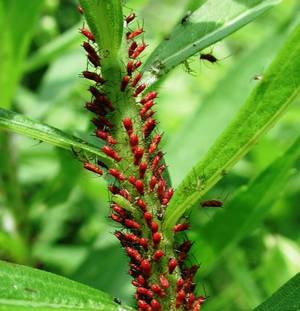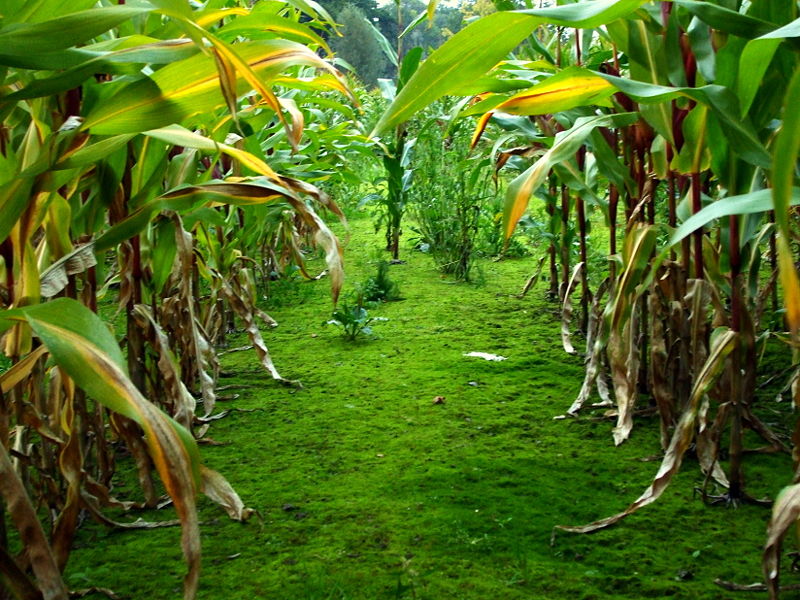Push-Pull - Using Plants as Natural Pesticides
Interview with
Chris - Tony: You're working at Rothamstead as well. You're looking at how plants actually produce chemicals which themselves can repel pests.
Tony - Yes, that's right. As James was talking about just a minute ago, plants themselves produce 2-300 compounds which are volatile chemicals on the surface of the plant. It's what gives them the smell to us but it's also what gives them the smell to the insects which try to colonise that crop and cause damage to it.
Chris - So the insects are sniffing out lunch by following the odour of the plant?
Tony - Yes.
Chris - And can the reverse also be true because James was saying that you can get humans that are naturally repellent to mosquitoes? Are there plants that are naturally repellent to plant pests?
 Tony - Well, in this country aphids are, in particular, a nuisance pest for our crops. They've designed their olfactory system to go to the crop and find the specific one that they want to have for lunch., as it were. So there are compounds given out by that crop which that particular aphid really wants to go for. In the same way it's not going to waste time going around trying to find crops where they're not there. So there are some chemicals given off by none-host plants that the aphid doesn't want to go to. They can repel the aphid.
Tony - Well, in this country aphids are, in particular, a nuisance pest for our crops. They've designed their olfactory system to go to the crop and find the specific one that they want to have for lunch., as it were. So there are compounds given out by that crop which that particular aphid really wants to go for. In the same way it's not going to waste time going around trying to find crops where they're not there. So there are some chemicals given off by none-host plants that the aphid doesn't want to go to. They can repel the aphid.
Chris - So by planting those near to a plant which you want to have as a crop you could mask the smell of the attractive with the nasty one and then you repel the pest?
Tony - Yes, we have a project going on at the moment in Kenya in East Africa and in that region the people there are subsistence farmers. They want to grow maize. Maize is a very important crop there. It's subsistence farmed but the maize is attacked by a stem borer pest. That's a moth which lays eggs on the maize and the eggs hatch, create caterpillars, the caterpillars eat out the centre of the maize plants and they fall over and die so there's no food. We put together a push-pull system in that part of the world where we're using plants to control what those moths are doing. Round the outside of the field we have a plant which is very attractive to the moths so the moths will want to go there rather than go to where the maize is. The maize is protected from those moths. At the same time, in between the maize which is growing in the field, there are some plants planted which give off a chemical signal to the moth that would come in that says these plants are already damaged. The volatile chemicals that they give off simulate or are the same chemicals as what would be produced by a maize plant if it was damaged. Any insects that are inside the field looking for a good place to lay their eggs, they're going to think that's not a good place for me.
Chris - Because it's already been half damaged? They think someone else has got there first and eaten all the food?
Tony - That's right the signals tell them that this is not a good place.
Chris - Ok, so it sounds good on paper but does it work? If you do objective studies on this and count numbers does it work?
Tony - Yes. It works beautifully in East Africa at the moment. Because there is such a lot of damage caused by these stem borer pests and the expense of having pesticides in there is just not possible for subsistence farmers. While their yields are quite low because they haven't got chemical inputs like we have in Europe the yields are very low. If you can increase those by using this push-pull approach where you're pulling the insects out in to those trap crops, pushing them away with the inter-crops away from that maize then you get significantly more yield with it. 2-4 times the yield is common in these areas.
 Chris - What about other kinds of pests because it's not just insects which are a pest. Elephants are as well in Africa and I don't expect you to do anything about that but plants themselves can be a pest. I've got bindweed galore in my garden at home and I know there are certain forms of that which can be a real nuisance. Is there any way of dealing with the plants themselves?
Chris - What about other kinds of pests because it's not just insects which are a pest. Elephants are as well in Africa and I don't expect you to do anything about that but plants themselves can be a pest. I've got bindweed galore in my garden at home and I know there are certain forms of that which can be a real nuisance. Is there any way of dealing with the plants themselves?
Tony - Plants themselves are also producing chemicals through the roots. We've talked about volatile chemicals that insects locate or avoid their host plant. Plants also produce materials in the soil. That's a battleground as well so they'll be trying to compete with other plants.
Chris - So they can literally fend off another plant?
Tony - Yes.
Chris - If they decide they don't like it by secreting something into the soil?
Tony - That's right.
Chris - And how can you use that?
Tony - It can be from the roots or the folia or material above the ground which then falls to the earth.
Chris - And how can you use that? Do you have plants that are friendly to crops but unfriendly to weeds then?
Tony - Well, this project in Africa that I was talking about just now. One of the crops that we put in between the maize to repel the insects: when that was used in the field situations we found that it completely stopped a parasitic weed which normally attacks maize as well. This weed's called Striga hermonthica. It's a Striga plant, it's a witch weed and causes massive damage. We found that the intercropping that we use - the intercrop that we use in particular is called Desmodium (silverleaf is the common name). This was producing chemicals in the roots, naturally occurring chemicals in the roots which it uses in its own ecology. This was affecting the Striga seeds and preventing them from germinating in the soil and then attacking the maize plant.










Comments
Add a comment